Lisa Schibley
In 2008, Glorianna Davenport and Evan Schulman had a decision to make. Throughout the 80s and 90s, their successful 600-acre Tidmarsh Farms in Plymouth was producing 1% of Ocean Spray’s cranberry crop, but when the time came to move on none of the couple’s three children had an interest in continuing the work. Once they decided to sell, however, there was plenty of enthusiasm from local developers. One proposal showed an impressive subdivision of more than 400 homes. But Davenport, a cofounder of MIT’s Media Lab, and Schulman, a financial entrepreneur, chose another direction.
Instead of selling to the highest bidder, they committed to restoring the Beaver Dam Brook wetlands to their original splendor, launching the Tidmarsh Farms Restoration Project, the largest freshwater wetland restoration project to date in the Northeast. Nine dams were eliminated, over three miles of meandering stream channel were created, and thousands of tons of sediment were removed to reconnect the headwaters of Beaver Dam Brook to the ocean for the first time in a century. In place of the monoculture of cranberry bogs, there emerged a mosaic of ponds, streams, red maple and Atlantic white cedar swamps, grasslands, and pine-oak forests that patchworked the property.
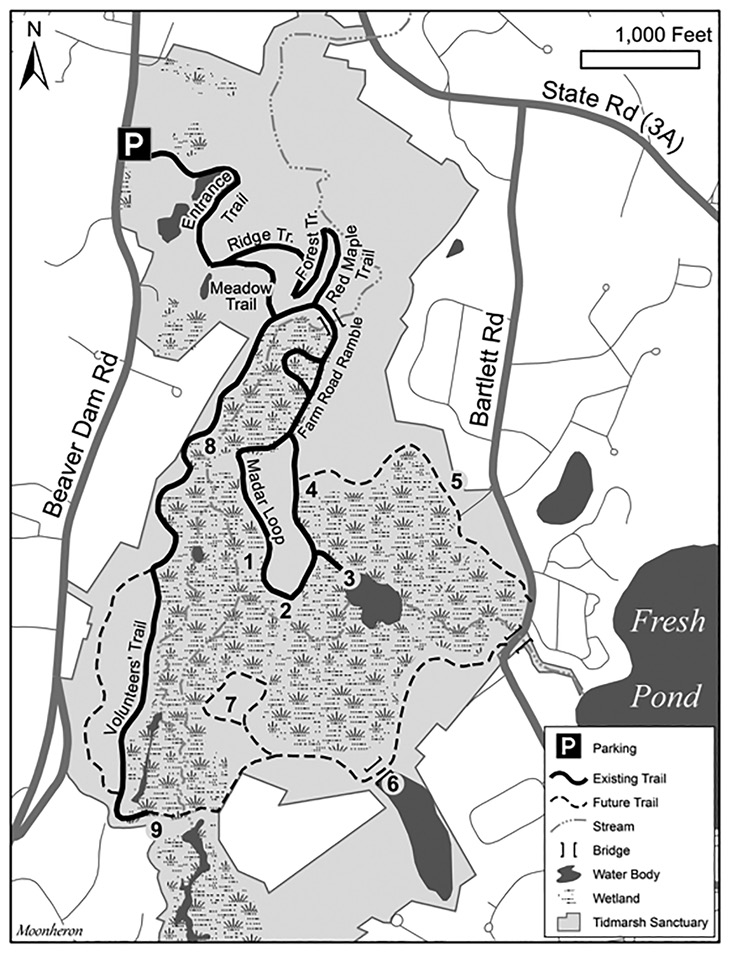
Tidmarsh Sanctuary, Plymouth, Massachusetts.
In 2011, Davenport and Schulman founded Living Observatory with a mission "to tell the long-term story of the Tidmarsh Farms Wetland Restoration and to advance scientific knowledge and public understanding of wetland ecology." In 2017, the Mass Audubon Tidmarsh Campaign, through state and federal land conservation grants and individual donations, raised the $3.6 million needed to acquire the property, and it officially became the Tidmarsh Wildlife Sanctuary.
As of spring 2019, there is no complete loop around Tidmarsh. The sanctuary managers ask that visitors do not cross Beaver Dam Brook—which flows through the entire property—anywhere other than the bridge on the Farm Road Ramble. On many of the trails, you must double back to return to the parking lot. The Volunteers’ Trail (which will be covered at the end of the article) is about a mile long, running north to south along the west side of the sanctuary, and does not connect with the rest of the trails except at its northern end; the trail itself is two miles out and back. Or it is just over a three-mile roundtrip from the parking lot. Depending on the amount of time and energy you have, you can choose walks along the rest of the sanctuary trails that vary from a couple of miles to more than six miles roundtrip.
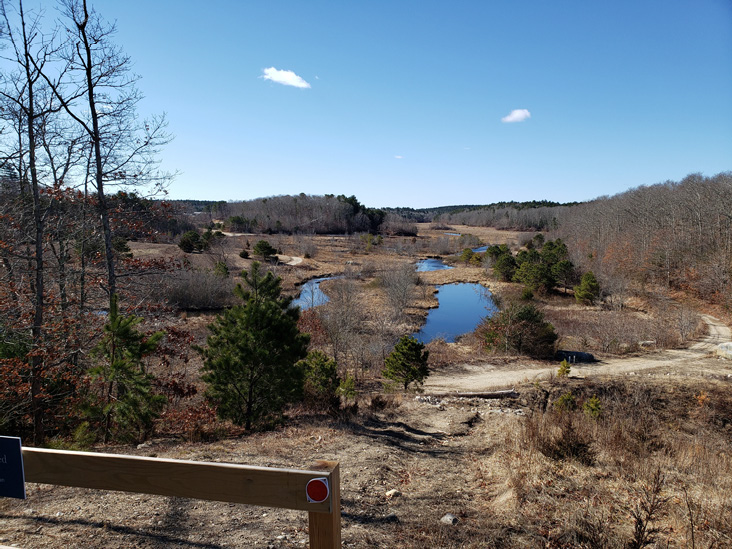
View from the overlook. All photographs © Cyndi Jackson.
Begin your exploration of Tidmarsh right around the parking lot at 60 Beaver Dam Road, with a possibility of Eastern Bluebirds any time of year in the adjacent open area. The start of the Entrance Trail is a good place for warblers during spring migration. In the first 100 yards, there is an open area on the left side of the trail with a thicket and birch trees. Listen for breeding Prairie Warblers in the summer and Common Redpolls in irruption winters. Eastern Phoebes often arrive here early and linger late.
The next section of the Entrance Trail is mixed pitch pine and oak forest with a number of potential Eastern Screech-Owl roost sites, so it’s worth taking your time passing through. As you near the small pond, listen for warbler chips. Spring migration brings Northern Parula, American Redstart, Magnolia, and Black-throated Green warblers here. Although the view is hidden by a row of bushes, approach the pond slowly and carefully because there may be a pair of Wood Ducks just out of sight to the right. Also, spend a few minutes watching for the resident river otter and scanning the bank for pond amphibians. The woods on the left are wet and boggy, particularly good for Black-throated Blue and Black-and-white warblers in spring migration.
As the trail curves around the pond to the right, peer down the drainage outlet to your left. In wet seasons, the waterfall out of the pond can make it tough to hear, but the thickets lining the stream bed can be productive. Historically, this blocked path led to the Red Maple swamp, but access is currently limited while the sanctuary works on a management plan.
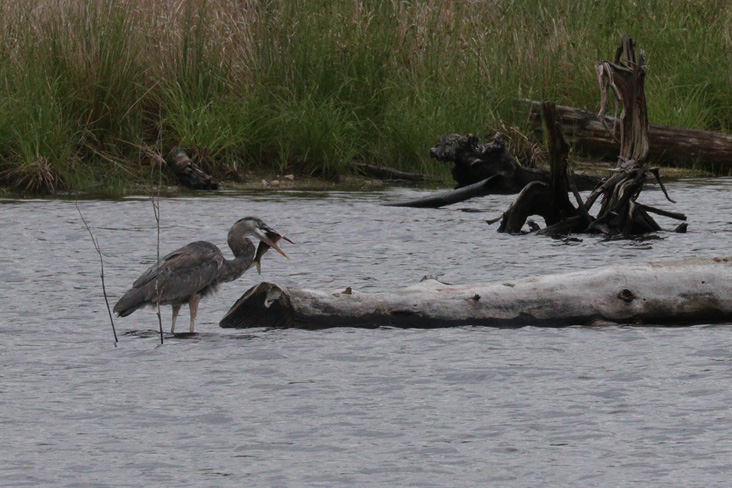
Great Blue Heron
The trail continues to curve around the pond, and you are headed toward a different habitat. Tall white and pitch pines surround the trail. Here you can find Golden-crowned Kinglets, Red-breasted Nuthatches, and Brown Creepers even in non-irruption years.
The Entrance Trail dramatically opens at 0.4 miles where the dense forest gives way to an open field with numerous boulders deposited by the receding glaciers. The edges just to the left or right of the path are prime spots to find Field Sparrows. Also, look for American Kestrels and Eastern Bluebirds along with Savannah Sparrows and Indigo Buntings in the field, and watch for Hairy Woodpeckers around the edge of the woods. Where the trail forks, the choice is to go low through the Meadow Trail on a short direct path to the wetlands and the intersection of the Volunteers’ Trail and Farm Road Ramble, or to climb high up the Ridge Trail toward the overlook—which can be the highlight of any visit and worth the walk.
If you choose the overlook, follow the Ridge Trail up and scan the woods to the left for wintering Hermit Thrushes or for Ovenbirds in the summer. From the top, you can see the full length of Tidmarsh to the south, the Pinehills development to the west, and as far as Bartlett Road to the east. The views are dramatic and worth the effort. Plus it’s a great spot to watch for Red-tailed Hawks, Red-shouldered Hawks, Ospreys, and Bald Eagles. Turn left immediately after the platform to take the Forest Trail down, which brings you through a mixed forest that can be good for warblers in spring migration. The trail ends at the Red Maple Path. Looking left, you can see the southern tip of the red maple swamp. In fall and winter, this spot is occasionally good for Winter Wrens, so keep an ear out for their squeaky klip-klip.
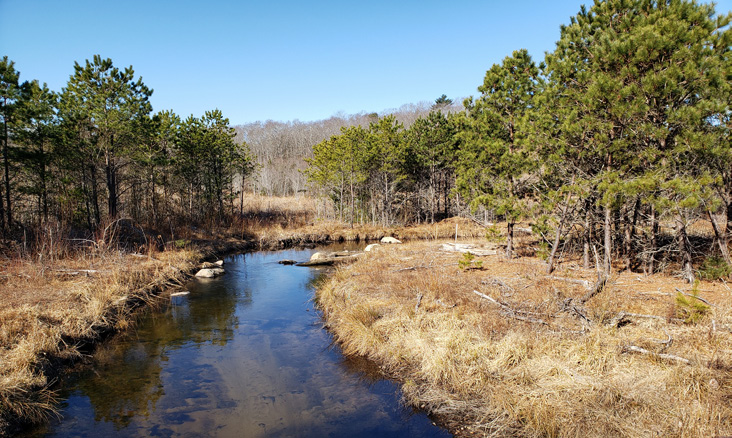
View of Beaver Dam Brook from the bridge.
Head right down the Red Maple Path to approach the wetlands. You are at the northern tip of the original cranberry bogs, where Beaver Dam Brook exits the property, passes under Route 3A into Bartlett Pond, heads out to Whitehorse Beach, then finally flows into the ocean. At the intersection, you can turn right toward the Volunteers’ Trail or left for the Farm Road Ramble and Madar Loop. Either direction is well worth exploring.
For now, turn left and follow the Farm Road Ramble trail with the watercourse on the right. At the bridge over Beaver Dam Brook, check for Eastern Phoebes in summer. You may be lucky to find a pair working on a nest. Also at the bridge, look for monitoring equipment. Scientists continue to monitor and study ecological change across the property as the transformation from bogs to wetlands continues, and they often have equipment here in the stream. This is also the spot where citizen scientists count herring during April and May. Before 2015, water control structures blocked the herring’s passage, but since they were removed, herring have been able to travel through Tidmarsh and successfully reach Fresh Pond, the main freshwater spawning pond of this watershed.
You are near the pines again, and this is another good spot for Golden-crowned Kinglets, Red-breasted Nuthatches, Chipping Sparrows, and Brown Creepers. The small loop on the right gives you the first good look at Beaver Dam Brook with an excellent chance for resident Swamp Sparrows. The habitat of the next part of the trail system is uniform. The meandering brook creates open patches of water at irregular intervals, and any one of these can hold ducks; most common, of course, are Mallards and American Black Ducks. In winter, Green-winged Teal, American Wigeons, Gadwalls, Buffleheads, and Hooded Mergansers are also regular. More unlikely are Northern Pintails, Eurasian Wigeons, and Northern Shovelers.
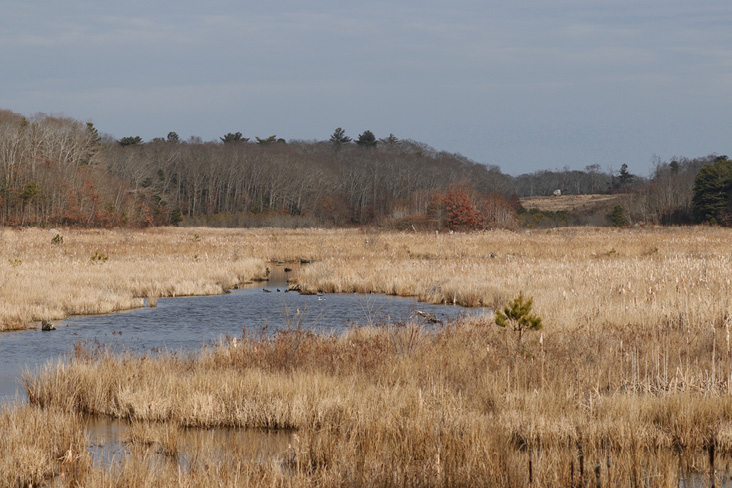
View from the end of the Volunteers’ Trail.
Head right at the Madar Loop intersection to keep the excellent duck habitat on your right. Unfortunately, most of the water is hidden from view behind the reeds and grasses, and the ducks are seen in glimpses rather than in long, pleasing views. When the water does open at a couple of vantage points (1 and 2), it is worth standing quietly for a while since ducks will often float by. There are future plans to add additional bridges and boardwalks to Tidmarsh, so as the sanctuary evolves, access to these spaces should be enhanced.
At the southernmost point of the Madar Loop, you have the best view of the rest of the sanctuary from this side of Beaver Dam Brook. This is a great place to scan for Northern Harrier in the winter and American Kestrel in the spring and summer, plus Great Blue Heron, Green Heron, and the occasional Great Egret in summer. It’s also a good place to look through the innumerable swallows that call Tidmarsh home in the summer; Barn, Tree, Northern Rough-winged, and Bank are all regular.
Shortly after the loop turns north, there is a spur trail on the right to the Tidmarsh Pond overlook (3). This is the one spot on the property where diving ducks are more common: Red-breasted and Common mergansers, Common Goldeneyes, along with Double-crested Cormorants, and occasionally American Coots and Pied-billed Grebes. The overlook is another great spot to sort through the swallows.
Continuing north, you will come to an unnamed trail (4) to the right that is considered an access road by the Mass Audubon staff. It is not an official trail, but birders are welcome to walk along the road. Mass Audubon is hoping to construct additional trails within the next year that will double Tidmarsh’s trail mileage, and everything listed as “future trail” on the map will be open to visitors. If you don’t have a lot of time, stay on the Madar Loop to return to the parking lot via the Farm Road Ramble, the Meadow Trail, and the Entrance Trail; this route is just under three miles from your car and back. If you are up for a longer exploration, head out along the access road.
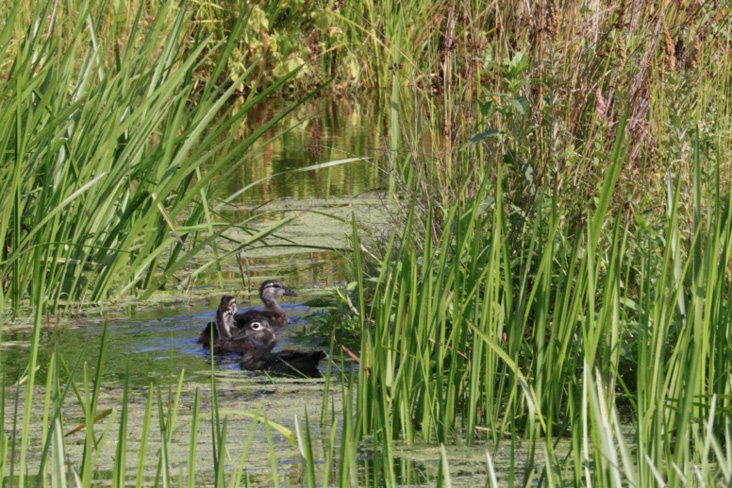
Female Wood Duck with ducklings.
At this intersection, there are a number of often-occupied bluebird boxes, and this is the best spot to photograph these charismatic birds. Farther on the left there is a sand borrow pit that was used in the cranberry operation. Along the upper left sandy bank look for Northern Rough- winged Swallow nesting holes. The next part of the access road travels through excellent sparrow habitat (5) from the intersection all the way to Bartlett Road. In winter, you can find Chipping Sparrows, Field Sparrows, American Tree Sparrows, White-throated Sparrows, and Savannah Sparrows. During October, look for White-crowned and Lincoln’s sparrows, and if you are lucky, you might just pull out a Clay-colored Sparrow. In winter, this is a good area to find Eastern Meadowlarks.
The point where the access road meets Bartlett Road is a good place to turn around. But if you are up for a longer walk, there are several other spots worth visiting. Remember, there is no way to reach the Volunteers’ Trail on the southwest corner of Tidmarsh from the access road to complete a closed loop, so you will have about three miles of backtracking to the parking lot after you continue to the end.
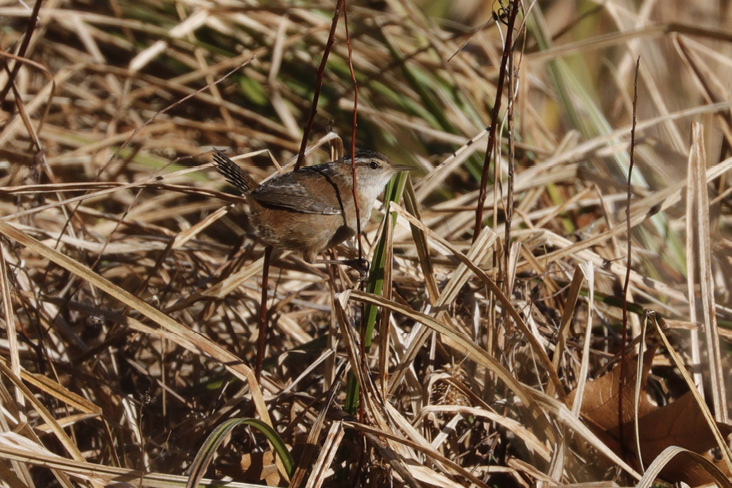
Marsh Wren.
After crossing the Bartlett Road bridge (very carefully because the bridge is narrow and the drivers travel too fast and generally are not paying attention), continue south on the Tidmarsh access road. Off to the right is another good spot for Eastern Meadowlarks in winter. The road passes through forest. When you reach the bridge over “The Arm” (6), look for Green-winged Teal in winter and warblers and vireos in summer. Beyond the bridge as you approach the greenhouses, the large overgrown mound is often good for sparrows. Across from the greenhouses, a small patch of open land is currently being managed for shorebirds. Least, Spotted, and Solitary sandpipers are possible in fall migration, dependent on recent rains. The last spot worth visiting on this side of Tidmarsh is the grassland hill (7). Not only is it good sparrow habitat, but it has views of several of the best spots for ducks that are not visible from other trails.
A walk around the small loop is certain to flush several groups of ducks in winter, so proceed slowly. At this point, you are about three miles from the parking lot, with the possibility that the walk back will be just as productive as the walk out.
The final area of Tidmarsh to cover is the Volunteers’Trail, which begins at the end of the Meadow Trail. Named to recognize Mass Audubon’s valuable volunteers, this trail takes you south along the western edge of the sanctuary. The thickets on the left where the trail starts are good for Nashville and Orange-crowned warblers in fall migration and have yielded the occasional Connecticut Warbler. Listen for Eastern Phoebes and Least Flycatchers in spring.
When the trail opens up, there is an excellent cattail marsh on the left. From here to the end of the trail, listen for the energetic chit of the Marsh Wren in fall and winter, as usually several can be heard. The restored marsh has become attractive to Belted Kingfishers and Green Herons, both of which can easily be found. Be ready to jump if you are lucky to flush a snipe, which are found occasionally in the drainage ditches.
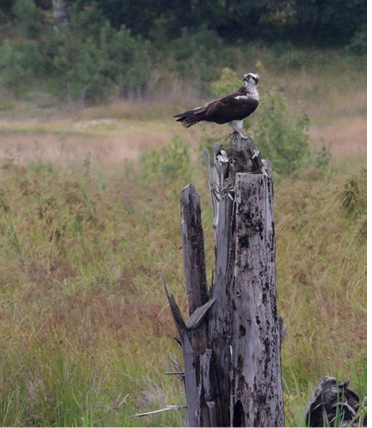
Osprey.
When you reach a bench overlooking the wetlands (8), this is an excellent place to sit and quietly listen for rails. Virginia, Sora, and King rails all are possible, although only Virginia is likely. The stretch of trail after the bench is excellent for passerines, early Pine Warblers, late Palm Warblers, warbler and vireo flocks in migration, breeding Baltimore and Orchard orioles, and Great Crested Flycatchers, plus on occasion, unusual species, such as White-eyed Vireo or Black-billed and Yellow-billed cuckoos.
As the trail continues, the diversity of passerines decreases, but the ducks start drawing attention again. For the last 0.25 mile of the Volunteers’ Trail, a long stretch of open water is in view, which often has a good variety of ducks. At the end, the Volunteers’ Trail rises up to give a view (9) of what was Beaver Dam Pond and is now a cattail marsh. Again, listen for rails and Marsh Wren here, and keep watch for American Bittern. This is an excellent place to scan for kestrels, egrets, herons, raptors, and swallows. It is one of the best places to get good views of Orchard Orioles. On the mile-long walk back, look and listen for the species that you might have missed earlier.
To reach Tidmarsh Wildlife Sanctuary from the north: Take MA-3 south to Exit 4 for Plimoth Plantation Highway in Plymouth. Follow Plimoth Plantation Highway for 1.7 miles until it turns into MA-3A south. Continue on MA-3A south for 2.5 miles, and turn right onto Beaver Dam Road. 60 Beaver Dam Road will be about 0.6 miles down on the left. From the south: Take Exit 3 from MA-3 north. Turn right onto Clark Road. In 0.7 miles, Clark Road becomes Beaver Dam Road. 60 Beaver Dam Road is 2.5 miles down on the right.
Lisa Schibley is an avid birder from Plymouth, Massachusetts. She works at Manomet Inc. as a Program Associate supporting the International Shorebird Survey and other shorebird projects. She began birding in the early 90s in Tucson and eventually led trips for Tucson Audubon and coordinated the Tucson CBC. After a 13 year hiatus due to the arrival of James and then Edison (who show no interest in birding), she picked it up again in 2015 with passion and enthusiasm for everything birds and birding. She currently is a member of the South Shore Bird Club and loves making connections with birders who want to learn more about Manomet and birding the Plymouth area.